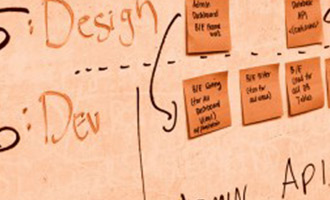The pull of print: Don’t lose the thought leadership ‘thud’ factor
Rob Mitchell
If I had a penny for every time a client tells me they want a ‘digital first’ thought leadership campaign, I wouldn’t be writing this blog – I’d be putting my feet up on a beach somewhere.
Digital is nothing new in thought leadership, of course: over the past three years, B2B content has migrated away from the traditional printed report and online PDF to a multichannel approach based around campaigns and digital microsites.
And yet rumours of the death of print remain exaggerated. I was surprised to read recently that global travel agent TUI expects to phase out printed brochures by 2020. By 2020? Given the rise of online travel booking over the past decade, I’d have thought this migration away from print, which is after all quite an expensive medium, would be taking place much more quickly. And yet, for now, marketing teams across a wide variety of disciplines remain stubbornly attached to the printed word.
The shift away from print is happening even more slowly in thought leadership. Although the rise of digital is undisputable, many companies continue to print thought leadership reports, albeit in smaller runs. If you visit the offices of just about any professional services firm, you’ll still find a stack of the company’s latest reports in the reception area, showing that print still retains its role as a reasonably important part of the marketing mix.
A premium product
So why are companies so wedded to print, despite all the talk of the shift to digital? An important factor is that, because they are now scarcer, printed reports are seen as a ‘premium’ product.
Receiving a printed report through the post, or being handed one at the end of a meeting, is sure to make the recipient feel more special than receiving an email attachment with the same report.
While digital is mass-market, print is a luxury product – the equivalent of getting a Gucci handbag as a gift rather than one from Marks & Spencer. This can be a powerful way of grabbing someone’s attention and starting a conversation with them. Smart marketers recognise that.
It means, however, that there’s more emphasis than ever on the quality of your printed reports. Digital printing has brought down costs, but it’s not always the same quality. It’s vital to use a good-quality printer, and select paper with a good stock, to ensure that the finished product maintains the sense of luxury.
Brought up on print
It shouldn’t be forgotten that the generation of executives who are sponsoring thought leadership – and the C-suite audiences they are trying to reach – tend to be people in their late 40s and older.
These are people who have grown up with print and who may be relatively less ‘digitally savvy’ than those in their 20s and 30s. They still want a report to put on the table when they visit a client, and are less comfortable handing over a USB stick or telling them they’ll email it over when they’re back in the office.
The recipients value print too, and many still prefer to read something printed when they are on a plane or train, for instance, rather than stare at a smartphone or tablet.
Our view at FT Longitude is that printed thought leadership reports have a shrinking, but still important, role to play in the marketing toolkit. As companies shift to a campaign mindset for their thought leadership, the goal is to produce a set of complementary assets that meet the needs of audiences who consume content in various ways.
Some will be happy to receive content online, or access it via social media; others will respond better to receiving a printed report through the post, or being handed one by a company representative.
Opportunity ‘thuds’
Sharp marketers recognise that the reduced volume of printed materials provides an opportunity to achieve greater impact when sending reports to clients and prospects, despite the inevitable higher costs. The key is to select the recipients of those reports carefully.
Looking to the future, it seems likely that the decline of print will continue in thought leadership, but I predict that companies will still be handing out thought leadership reports after TUI has stopped handing out travel brochures. As one partner in a professional services firm once told me, digital just doesn’t have the “thud factor” of a high-quality, well-researched printed report.
Speak to the team
We’ll help you to navigate and overcome any challenges you currently face and learn how to get more out of your content.
Book a meeting
About the author: Rob Mitchell
Rob is our CEO and co-founder and leads FT Longitude’s strategic planning and sets the overall vision and priorities for the business. He manages the board-level relationship with FT Longitude’s parent company, the Financial Times group, and also oversees FT Longitude’s finances, people management and administration.
Prior to co-founding FT Longitude in 2011, Rob was an independent writer and editor. Between 2007 and 2010, he was a managing editor at the Economist Intelligence Unit and prior to that he was an editor at the Financial Times, where he was responsible for the newspaper’s sponsored reports, including the Mastering Management series.
 |
Tel:
+44 (0)20 7873 4770
|
Tel:
+44 (0)20 7873 4770


